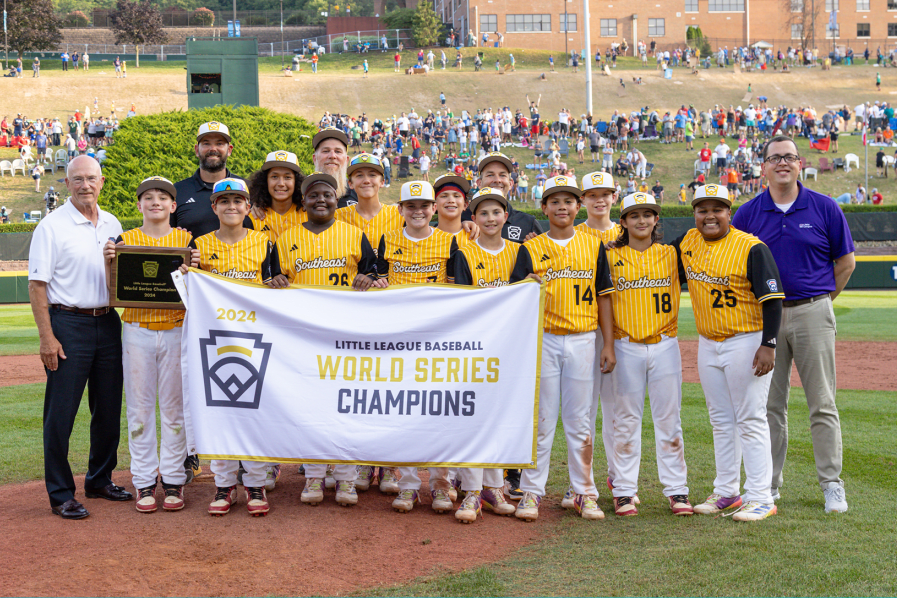There’s no bigger stage for a youth athlete than the annual Little League World Series, an international tournament for youth baseball stars every August in Williamsport, Pennsylvania.
Last year’s title game between the eventual champs Lake Mary, Florida, and Taoyuan, Taiwan, was a ratings winner attracting a larger average audience (3.5 million) than a major league game a week earlier in Williamsport between the Detroit Tigers and the New York Yankees (2.2 million).
What if the 10-, 11- and 12-year-old stars of that Little League game wanted to use their newfound (and probably short-lived) celebrity to cut NIL deals with a local pizza parlor or a supermarket? Could they?
The answer isn’t clear.
Four years after NIL became a possibility for college and many high school players, Little League has yet to publish a policy for the two million boys and girls who are playing on diamonds in the U.S. and around the world.
Capital News Service requested an interview with a Little League official to discuss the organization’s position on NIL. Little League replied with a statement that reads in part: “Until the name, image, and likeness parameters are thoroughly determined for all amateur athletes below the college level, we will continue to maintain our current policies.”
In a follow-up email, CNS requested clarification of Little League’s “current policies” on NIL.
A Little League spokesperson responded with a statement that said Little League “feels its role is to protect the young athlete’s eligibility for high school sports in baseball and softball.” It did not address whether Little League has a NIL policy.
There are indications that Little League discourages players participating in the World Series and elsewhere from participating in NIL.
A document posted on Little League Baseball International’s website titled “APPEARANCE OF LITTLE LEAGUERS” notes that children who are “identified as Little Leaguers, either verbally or by inference, MUST NOT appear in any creative, non-news story form of media, television, print, social, or otherwise, in videos (other than home videos for personal use, and not to be sold).” These restrictions would seem to rule out NIL.
Jonathan Anderson, coach of Lake Mary’s championship team, told CNS that he was informed by a Little League official during the World Series that NIL was not permitted. Asked if he would favor Lake Mary players pursuing NIL deals, Anderson replied: “No, because Little League does not support it.”
Whether Little Leaguers, even stars of the annual World Series, would attract interest for NIL deals is not clear.
Players in the World Series aren’t even teenagers yet. There are limits to the marketing campaigns that they could be involved in or the influence they might have over consumers.
Also, their stardom fades quickly. The Lake Mary players were heroes in their hometown near Orlando after outlasting their Taiwanese opponents in extra innings for the title. They were guests of honor at Disney World and invited to throw out the first pitch at a Tampa Bay Rays game. That was after they drove through town in a parade. But a week later they were back to middle school and their normal lives.
On the other hand, the fame of the 12 Lake Mary players has grown in ways that seem to be sticking especially on social media. On Instagram, one player, JJ Feliciano, has more than 3,000 followers. The Lake Mary Little League Instagram account has more than 4,500 followers and posts concerning the Little League World Series winning team have routinely earned more than 150 likes.
In the years before NIL, there occasionally have been players in the World Series who appeared to have the star power and marketability to help companies pitch their products.
In 1971, Lloyd McClendon on a team from Gary, Indiana, hit home runs in five consecutive at bats. McClendon later played eight seasons in Major League Baseball for the Cincinnati Reds, Chicago Cubs, and Pittsburgh Pirates.
In 2014, Mo’ne Davis was a media sensation when she became the first girl to earn a win and pitch a shutout in the Little League World Series. Davis was such a big star that she made it to the cover of Sports Illustrated with the caption: “Mo’ne: Remember Her Name.”
“She was incredibly popular and well known for a short period of time, so I’m guessing brands that would want to be affiliated with a young female star would have flocked to her,” said Greg Abel, CEO of Abel Communications in Baltimore. Abel added that he would not be surprised if there are opportunities in the near future for Little Leaguers “with an interesting backstory.”
Little League isn’t the only national youth sports organization that appears to be taking a wait-and-see approach to NIL. Pop Warner Little Scholars, the largest youth football, dance and cheer organization in the US with more than 400,000 participants, does not have a policy addressing NIL.
The organization, which suits up football players as young as five years old, isn’t likely to have an NIL policy soon, according to Tim Glase, Chief Operating Officer of Pop Warner Scholars. “Broadly speaking, I don’t anticipate anything in the near future” he said.
Pop Warner generally discourages its leagues from highlighting the touchdown passes and open-field tackles of its star players. That is in keeping with its philosophy of promoting teamwork over individual accomplishments. The organization also discourages its member leagues from collecting statistics on individual players, said the Pop Warner official
But trying to control NIL would be far more difficult, Glase said, noting: “The reality of it is, we can’t really police things that happen outside of the sport of football or the sport of cheer and dance.”

